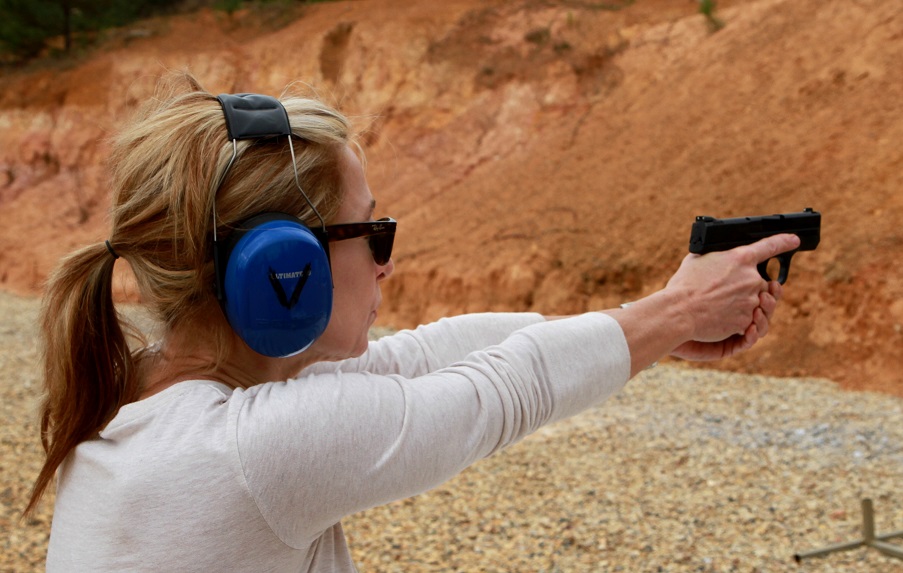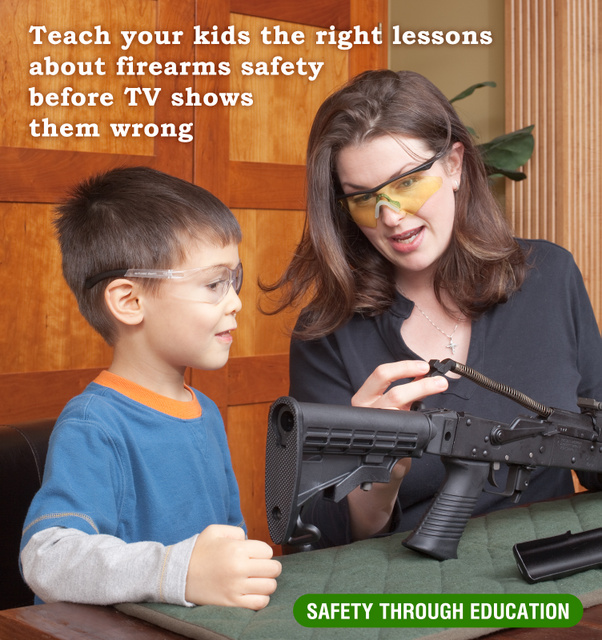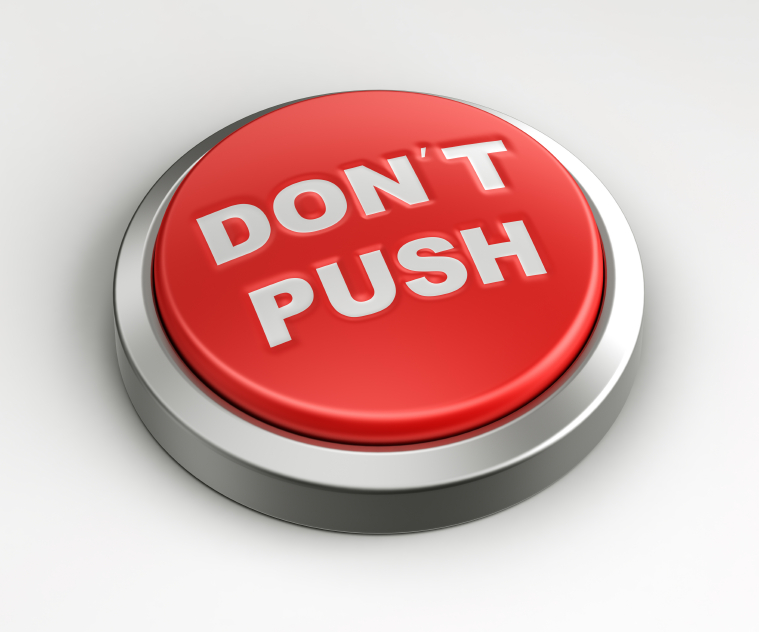When I was 11 or 12 years old, my family and I were out of state visiting relatives. While playing with my cousins who were about the same age, we discovered my uncle’s rifle on a rack in his room. This rifle instantly became the focus of our attention.
We asked my uncle for permission to take it off the rack and were told it was safe for us to check it out because it was unloaded. Excited, we moved quickly back to the room. When I took the .22-caliber rifle off the rack, I checked the chamber to verify it was unloaded just as my father had always taught me. I quickly realized it was loaded, as a cartridge came flipping out.
That memorable experience has been brought to mind many times over the years. We were young boys ranging in age from 9 to 12 and most of my cousins had never been exposed to firearms. Fortunately nobody was injured, but I believe the stage was set for a different outcome had I not been educated on firearms as a child. As I write this, two events have recently occurred in my area related to negligent discharges of firearms, one of which ended fatally.
Unintentional Firearm-Related Injuries and Deaths
Although much less common than other accidental deaths, unintentional and negligent firearm-related deaths do occur. The CDC’s latest statistics show 851 unintentional firearm-related fatalities in 2011, up from 606 in 2010. During 2012, 15,151 people went to the emergency room for BB or pellet gun injuries, and another 17,362 for accidental gunshot wounds that were not fatal. This number includes everything from hunting incidents to self-inflicted injuries. Having the proper education and understanding about firearms may have prevented all of these injuries and deaths.

A child’s interest in firearms, demonstrated here by pretend play. Photo: Istockphoto.com
www.personaldefensenetwork.comTools Require Training
Firearms are inanimate tools that can be dangerous without the proper knowledge and instruction on how to handle them safely. As parents and gun owners, it is our responsibility to properly educate those around us on firearm safety, just as we educate our children about other inanimate objects such as automobiles, swimming pools, and table saws.
Some readers may argue that guns aren’t even allowed in their homes, but the responsibility to teach your children should not be disregarded. Firearms are a big – and permanent – part of our culture. A 2011 Gallup Poll (latest available) revealed approximately 47% of households in the United States have a firearm in the home or somewhere on the property. This means nearly a 50/50 chance that your child could have access to firearms when playing at a friend’s home.
Bringing firearm safety to schools would be one way to help educate children and parents alike. Historically, our school systems have used awareness programs to bring about positive changes. For example, the CDC reported a 54% decline in drinking and driving among high school students 16 years and older with awareness programs being a contributing factor. Through education, smoking among U.S. adults and teens has also become much less common. Teen pregnancies have declined steadily over the past decade using similar awareness agendas. Likewise, the CDC found that “to reduce sexual risk behaviors among youth, schools and other youth-serving organizations could help young people adopt lifelong attitudes and behaviors that support their health and well-being—including behaviors that reduce the risk for HIV, STDs, and unintended pregnancy.”
In the late 1980s, the NRA started the Eddie Eagle GunSafe® Program, which teaches pre-K through third grade children four important steps to take if they find a gun: Stop! Don’t Touch. Leave the area. Tell an adult. The program has reached more than 26 million children in all 50 states. Although a great starting point for schools to incorporate, I believe its weak point is ignoring human nature and children’s curiosity.
Don’t Push That Button
When my son Larsen started to walk, he also became interested in the contents of our kitchen drawers, including the knives. My wife and I instructed him that knives could hurt him and not to touch them. He understood that and it kept him from handling the knives for a few months. But the more forbidden they were, the more they drew his interest, and the braver he became. We quickly learned his curiosity outweighed our wishes.
When our original “Don’t touch” plan failed, we were forced to devise Plan B. I knew if the knives were simply moved to a new location, his interest in them would not change. Our new plan was to teach him how to handle knives properly and take away his curiosity by allowing him to explore them. He was taught which end of the knife to stay away from and how to hold it. With our supervision and help, he even began cutting food. He was also instructed not to touch a knife without his mother or me helping him. This removed his curiosity and reduced the chance of him getting hurt by examining knives unsupervised. I believe the latter is what NRA’s Eddie Eagle program is missing. If we really want to reduce unintentional shootings, we need to teach awareness and safety, but also remove the mystery of firearms by allowing our youth to explore guns safely.
Handling Firearms Safely
Safe handling rules need to be taught to all individuals who could potentially have access to firearms. A few different versions of safe handling rules are taught throughout the training industry. In my courses, I teach three rules to be followed at all times.
• Rule #1: Keep your finger somewhere other than inside the trigger guard unless you’re shooting. We want our finger straight and deliberately out of the way, reducing the chance of a negligent discharge.
• Rule #2: Keep the gun pointed in a generally safe direction whenever possible. If you do have a negligent discharge, it also usually takes breaking the second rule to injure someone.
• Rule #3: Keep in mind that you’re responsible for a firearm. If used negligently or maliciously, you can cause injury or death. This is more of a mindset or “big picture” rule. Don’t handle a firearm in a careless or complacent manner because you feel someone will not be injured. I’ve seen plenty of students try to justify it being okay that their finger is on the trigger because it is unloaded or on safe.

Student with finger staged in the correct position, indexed along the slide and straight. Photo: author
www.personaldefensenetwork.comProper Storage
For firearm owners, our responsibility begins with proper storage. Regardless of how we store firearms, it is imperative to prevent unauthorized access to younger or uninformed children. Hiding or placing a firearm out of reach, unloaded or not, is not preventing access. When I was three years old, my mother found me climbing on cabinets near our fireplace and striking matches while sitting on the shelves. I see my two year old climb and explore in the same way. Never assume they will not find a gun or lack the strength and capability to operate it. Too often, this is how kids hurt themselves with firearms.
How we store our firearms can look very different from one person to the next. A bachelor living alone may be able to keep a home defense handgun in an unlocked nightstand drawer, but a parent of little ones needs to take other measures to ensure safety. When concerned about efficient access for home defense, I prefer to use a fast-access handgun safe. These are constructed to hold not much more than a handgun and spare magazine, so they can fit in places like a drawer or cabinet. The design allows for quick access through a biometric or keypad lock, but still prevents illicit access.
Appropriate Mindset
Some firearm-related unintentional injuries and deaths are caused by a complacent mind; the person who was taught how to handle firearms safely but fails to do so. Locally and nationally, we’ve had an abundance of examples, from gun show attendees and gun store employees to police officers and firearms instructors who have negligently discharged a firearm. Another story making headlines this week is a police sergeant who negligently killed an unarmed female during a raid. When a flash-bang grenade went off, the officer's startle response caused him to fire his handgun while outside the house. Police were unaware he had even fired his weapon until going inside and finding a female shot in the head. You mustn’t allow for complacency when handling firearms.
The value and importance of educating and properly training our youth are immeasurable. The great majority of incidents are easily prevented if we take the necessary steps to inform those around us. With Christmas here and many kids receiving their first firearms, now is the time.



A good article and the information continues to be of value. Everyone can use a hammer, it's a tool, but many choose not to. According to FBI statistics, in 2017, 467 people were killed by blunt objects, which include hammers and clubs. This number is higher than the 403 people killed by rifles in the same year. *https://americanmilitarynews.com/2019/08/fbi-statistics-show-more-people-die-by-blunt-objects-than-rifles/ Teach the children well, they will grow into safe and responsible adults.
I COULD NOT AGREE, MORE WITH THIS STORY. WITH THAT SAID ALL CHILDREN SHOULD BE SHOWN THE PROPER WAY TO HANDLE A FIREARM.
Very good advise, very well written should be mandatory teaching sy every grade level.
You not only have to teach about gun safety but also about ammunition. As a 12-13 age a fiend took a bullet and put it in a vise and hit the end of the bullet with a hammer. The result was part of the bullet (22) case going thru his cheek, it could have been worse.
I agree with you 100 % without a doubt! Education of the safety rules of a gun and checking the chamber to make sure it is not loaded should be taught to children also, how to release the magazine.
As a senior citizen who lives with his firearm-trained wife and no one else in the house, I still keep all my staged firearms with combination-coded trigger locks or cable locks (all set to the same combination) except those in the master suite, the main purpose being so no home invader can find and use the firearm against me. It also provides gun safety at the same time. When we have guests, young or old, staying in the home, I also trigger-lock or cable-lock the firearms in the master suite, foregoing convenience for safety, unlocking the ones at the immediate bedside only when carrying them or when going to sleep, and we lock the door to the suite so no one can sneak in quietly and get to those firearms before we're awake enough to get them and use them safely. Our son, age 51, is well-trained in firearm use, and has no children, so we have little or no opportunity to train young children in safe firearm use.
One of the larger sporting goods chains in my area won't even allow you to handle a firearm unless you can demonstrate how to safety check it. If you can't, they will show you how, then have you repeat it until you get it right. Strangely though, there was one clerk there who seemed like a nice guy, but would casually muzzle me when showing me a handgun, and, when I pointed this out to him, his reply was, "we both know its unloaded". Finally one day he was helping a newbie female and her boyfriend, and in spite of being shown proper handling SEVERAL times, the female would muzzle everyone around the gun counter, with her finger on the trigger. He completely lost it and refused to show them anymore weapons, and when she went all "Karen" on him, he stupidly pointed a pistol right at her and asked, "so, how does this make you feel?" He was swiftly taken in the back and given his walking papers, but, the customers were also banned from the store for being unable to comply with safety rules.
I learned with four rules. #1) All guns are always loaded. #2) Never point a gun at anything you are not willing to see destroyed. #3) Always be aware where your gun's muzzle is pointed, and make sure it is pointed in a safe direction. #4) Never put your finger on the trigger until your sights are aligned on the target and you are ready to fire. Rules number one and four are the most important. If you get in the habit of always handling a gun as if it is loaded, even a revolver with the cylinder hanging open and empty, or an auto with the mag out and the slide locked back, and keep your finger OFF the trigger, there will be no casual waving around of the gun, and no chance of the trigger being pulled. Most negligent discharges happen with an"unloaded" gun. There is no "accidental" discharge. There is only "negligent", because if it goes off "all by itself", the operator was doing something stupid. Stupid and guns do not mix well. If you watch someone untrained in gun safety, they will almost invariably pick up a gun by it's trigger. It's been done hundreds of times in movies and TV, and it's positioned so your finger naturally falls there. It's one of the hardest things to train out of a newbie, but they have to learn it, or they will be forever unsafe. I personally would not someone shoot until they can recite the rules and be observed practicing them. They must also demonstrate that they know how to clear and unload the gun they are training with. I would suggest training new shooters on a double action .22 rimfire revolver. It is the simplest to operate and has minimal muzzle blast and recoil. Just load, aim, and pull the trigger. I tend to run on, but I hope someone finds this useful. Enjoy shooting and be safe.
When my oldest son at 12 visited Kenton, Ohio; the Chief of Police allowed him to fire a machine gun at their range. Growing up with around firearms had taught a very strong responsible message about firearms, their usage and there obvious reasons to be knowledgeable in their usage. My ex-husband took my boys to the desert and show them what shooting a jack-rabbit looked like after being hit with a 270 cal rifle round at 100 yards. needless to say there was very little left of the rabbit. The impression lasted a life time for my boys. They learned a great respect for firearms and the damage a gun can do. Both Jaime n Estefan never misused a firearm in their 50 years of life todate.
I work Security Post and Campus Patrols for JPMorgan Chase.